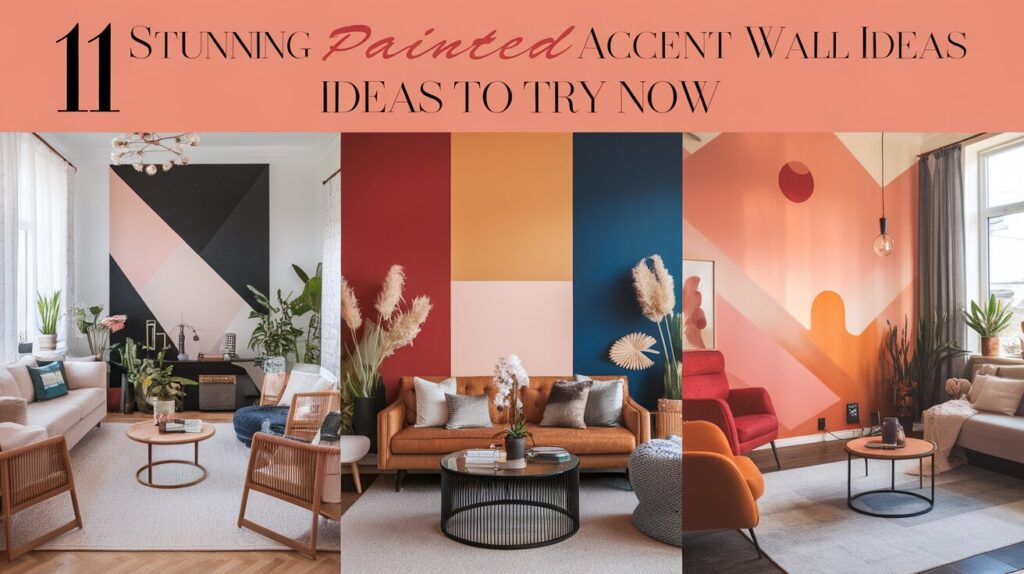A painted accent wall is a single wall that stands out through color, pattern, or texture. It creates a focal point that transforms a space without breaking your budget.
In 2025, these walls will remain popular because they will have a big impact for little cost. Social media continues to show how simple paint can create dramatic results.
In this guide, 11 tested accent wall ideas for any home are tested. We’ll cover how to pick colors, use various techniques, and avoid mistakes.
With 15+ years of design experience, we’ve chosen options for all skill levels. You’ll finish with all the know-how to transform a plain wall into the highlight of your home.
How to Plan the Perfect Painted Accent Wall
I’ve painted dozens of accent walls, and planning makes all the difference.
Pick the right wall first. Look for natural focal points where:
- Your eyes go when you enter the room
- Your TV or fireplace sits
- Major furniture, like beds or sofas, is placed
Avoid walls with many doors or odd angles. Ask yourself: Which wall do I see most often?
Colors can make or break your space. For subtle impact, go 2-3 shades darker than other walls. For drama, pick a contrasting color. Different colors create different moods:
- Blues/greens: calm
- Reds/oranges: energy
- Purples: creativity
- Yellows: happiness
Finish matters as much as color. For living areas, use matte or eggshell to hide flaws. For wet areas like kitchens, choose semi-gloss or satin for easy cleaning. Remember: more shine = more flaws show. Always test paint on your wall before committing!
11 Painted Accent Wall Ideas to Try Now
Bold Geometric Patterns Painted Accent Wall

Geometric patterns are walls featuring shapes like triangles, hexagons, or diamonds arranged in a regular or random pattern. These designs use clean lines and sharp angles to create visual interest.
I’ve seen these patterns transform boring rooms into modern showstoppers. You can create them with:
- Simple painter’s tape for straight lines
- Cardboard templates for more complex shapes
- 2-4 colors that match your room’s theme
Start simple if you’re new to this. Try a basic triangle or diamond pattern. The clean lines work great in living rooms and home offices.
Want to make it easier? Paint the whole wall one color first, let it dry completely, then add your shapes in a second color.
Ombre Fade Effect Painted Accent Wall

An ombre wall features a gradual color transition from light to dark or between related colors. It creates a smooth, flowing gradient rather than sharp color changes.
The soft color fade creates a dreamy, peaceful mood. Perfect for bedrooms!
You’ll need:
- 2-3 shades of the same color
- A spray bottle with water
- Several paint brushes or rollers
I find it easiest to work while the paint is still wet. Paint each color in sections, then blend where they meet using a damp brush. The trick is to work quickly before the paint dries.
My clients love this in nurseries and reading nooks, too.
Two-Tone Split Wall Painted Accent Wall
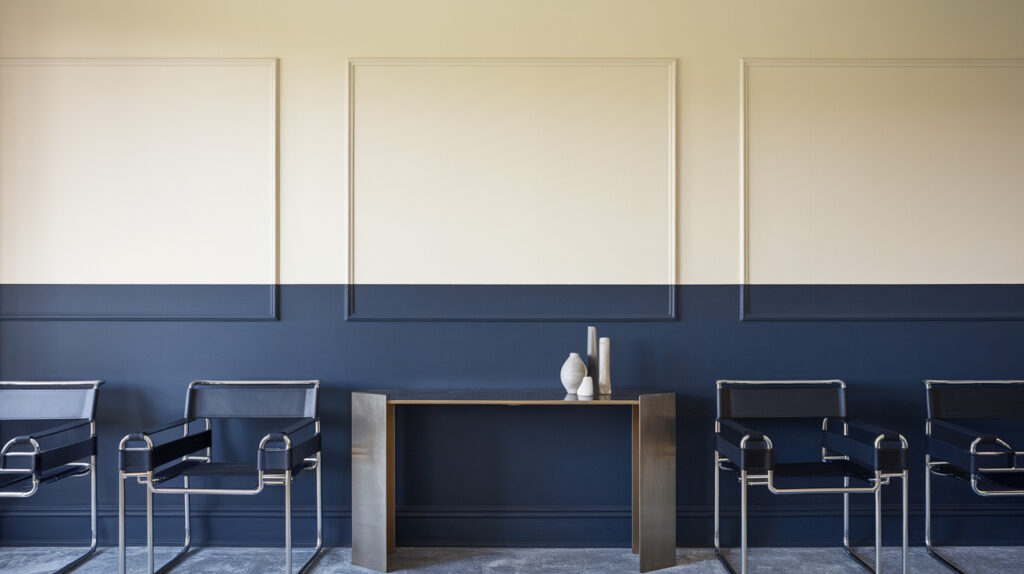
A two-tone split wall divides your wall horizontally into two distinct color zones. Unlike an ombre effect, the color change is intentionally clear and defined, creating a color-blocking effect that adds structure to your room.
You can:
- Go with a 50/50 split
- Place the line at chair-rail height
- Use contrasting or complementary colors
I’ve used this trick to make low ceilings look higher. Paint the bottom darker and the top lighter to draw the eye upward.
A crisp line between colors looks modern, while a slight blend feels more artistic.
Dark, Moody Hues Painted Accent Wall
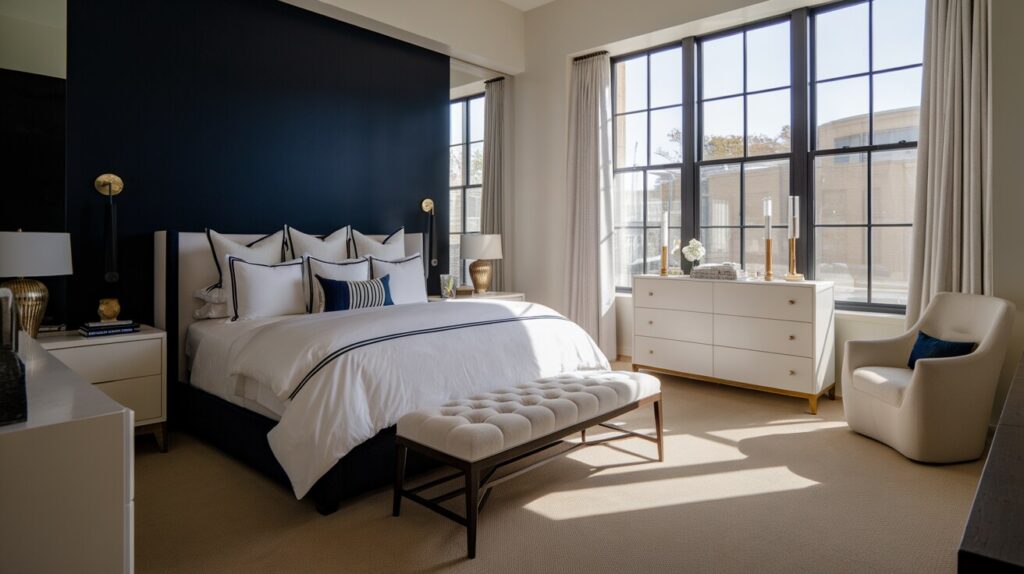
Dark, moody hues are deep, saturated colors that add drama and sophistication to a space. These bold color choices go beyond typical accent walls by creating a strong emotional impact and visual depth.
Deep, rich colors create a cozy, intimate feeling. Think navy blue, forest green, charcoal, or deep plum.
These colors work best:
- Behind a bed or sofa
- In rooms with good natural light
- When balanced with light furnishings
Test your lighting first! I once painted a wall deep navy, only to find it looked black at night. Make sure you love the color in both daylight and evening light.
Stripe or Checkerboard Painted Accent Wall
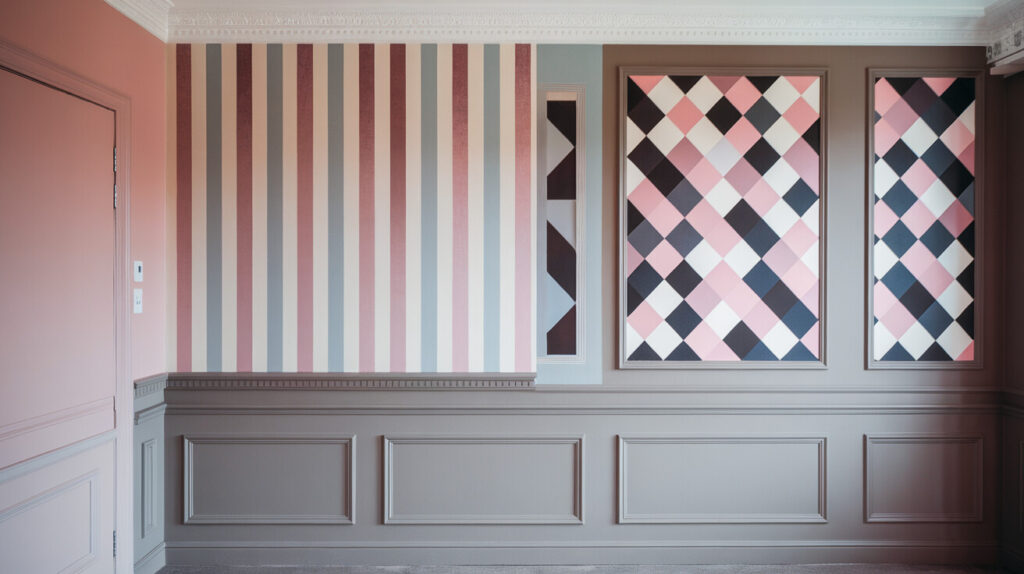
Stripe and checkerboard designs use repeating patterns of alternating colors to create visual rhythm on your wall. Stripes can be any width and run vertically or horizontally, while checkerboards create a grid pattern of squares in alternating colors.
Stripes and checkerboards are playful but can also look sophisticated.
For stripes:
- Vertical stripes make ceilings seem higher
- Horizontal stripes make rooms feel wider
- Vary the width for a custom look
For checkerboards:
- Use subtle color differences for elegance
- Go bold with high contrast for fun spaces
- Try different square sizes based on your room
The key is precise measuring. Take your time with the tape to avoid crooked lines.
Earthy Terracotta or Clay Tones Painted Accent Wall
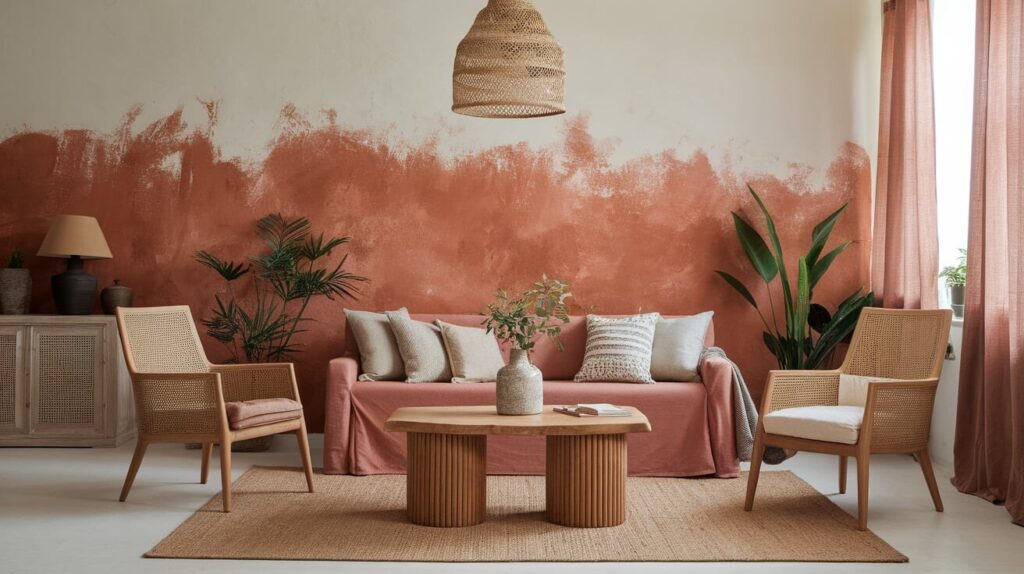
Earthy terracotta and clay tones are warm, natural colors inspired by baked earth and natural clay. These orange-brown to reddish-brown colors add warmth and grounding energy to spaces, creating a connection to nature.
Warm earth tones bring a natural, cozy feel to any room. I love terracotta, clay, and sand colors for their versatility.
These colors:
- Create a warm backdrop for plants
- Pair beautifully with natural materials
- Work in both modern and traditional homes
Add texture to enhance the natural vibe. Try a lime wash or color washing technique for depth.
These tones look amazing in dining rooms and living spaces.
Chalkboard or Writable Wall Painted Accent Wall

A chalkboard or writable wall is a surface painted with special paint that allows you to write directly on it with chalk or dry-erase markers. It combines decoration with function, creating an interactive space that can change daily.
This functional wall works well in:
- Kitchens for shopping lists
- Kids’ rooms for drawing
- Home offices for brainstorming
You need special paint for this, but it’s worth it. Regular chalkboard paint comes mostly in black or green, but you can now find it in many colors.
Prime properly before applying. A smooth surface makes all the difference in how well your chalk or markers will work.
Color Block Painted Accent Wall
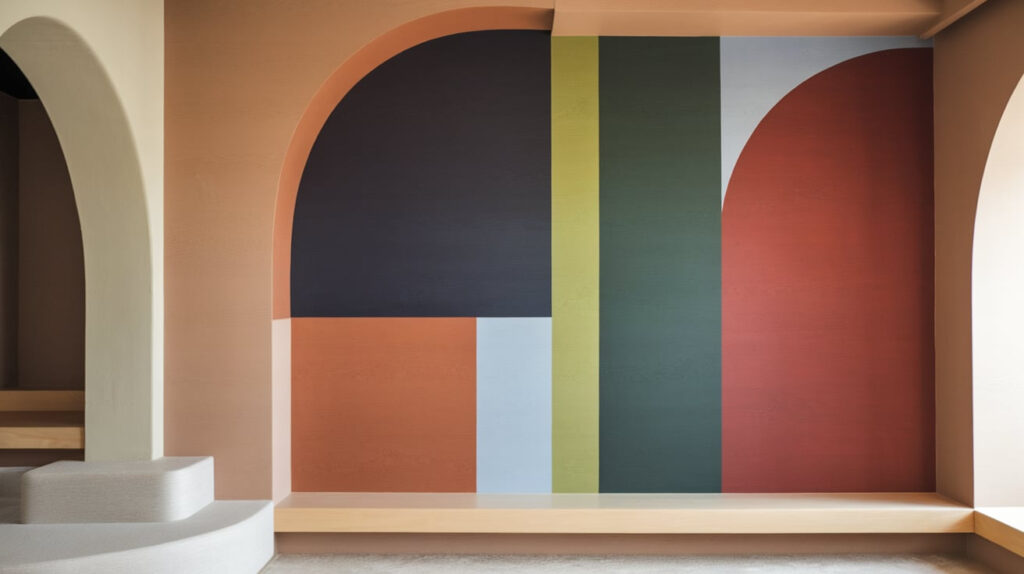
Color block designs use large, distinct sections of solid colors arranged in an artistic composition. Unlike traditional geometric patterns, color blocking creates a modern art-inspired look with bold, clearly defined color areas that complement each other.
Color blocking uses shapes of different colors for an artistic look. Unlike geometric patterns, these shapes can be more free-form.
Try:
- Arches and curves for a soft feel
- Angular blocks for modern spaces
- Overlapping colors for added interest
I find that odd numbers work best – three or five blocks usually look better than two or four.
This style lets you combine multiple accent colors on one wall.
Painted Ceiling as an Accent
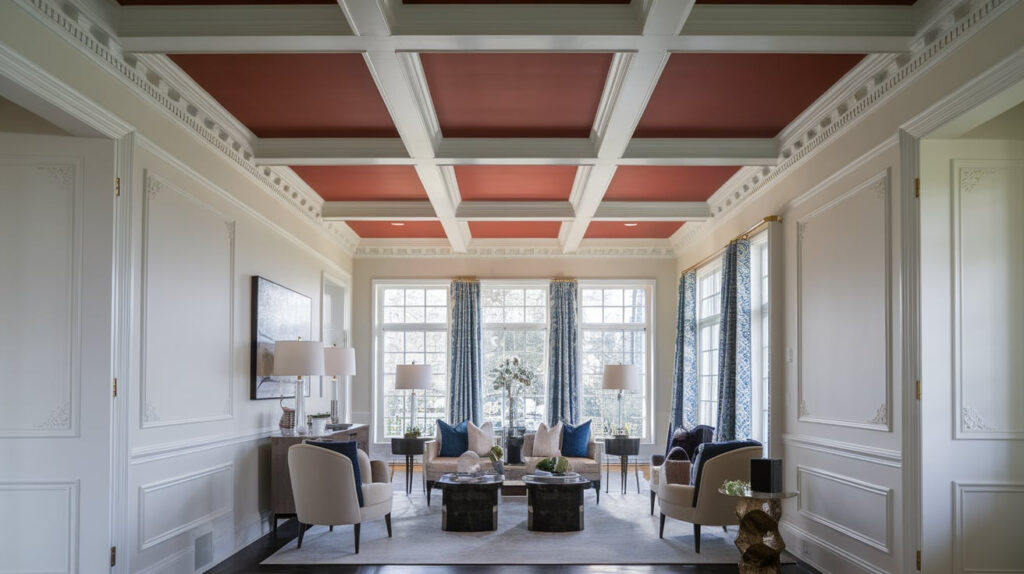
A painted ceiling accent treats the ceiling as another wall in your design scheme. Instead of the standard white ceiling, this approach turns the overhead surface into a feature with color that complements or contrasts with your walls.
Why limit yourself to walls? Your ceiling is the “fifth wall,” and painting it creates a stunning impact.
This works especially well in:
- Rooms with crown molding
- Spaces with high ceilings
- Small rooms that need personality
Light colors make ceilings feel higher, while dark colors bring them down for a cozier feel.
Just remember to use ceiling-specific paint and prepare for some neck strain during painting!
Stenciled or Textured Painted Accent Wall
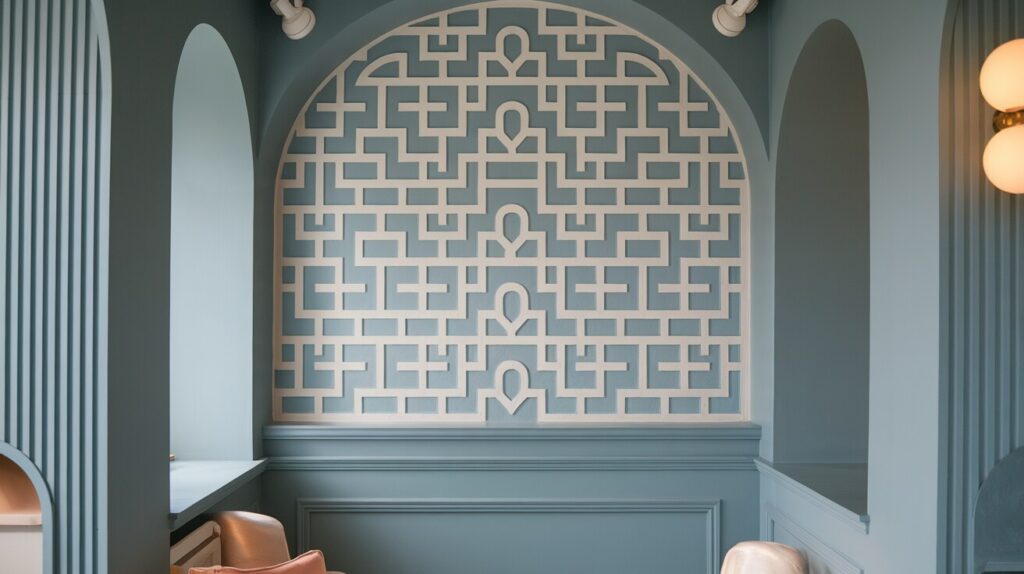
Stenciled walls use templates to create repeating patterns or designs, while textured effects use special application techniques to add physical dimension to the paint. Both methods create visual interest beyond flat color.
Add pattern and dimension without the hassle of wallpaper. Stencils come in endless designs, from simple repeating patterns to elaborate scenes.
For best results:
- Secure your stencil firmly with painter’s tape
- Use a nearly dry brush or roller to prevent bleeding
- Work in small sections
I’ve found that patience is key. Don’t rush between sections and allow proper drying time.
Texture techniques like rag rolling or sponging can also add subtle interest.
Seasonal or Theme-Based Painted Accent Wall

A seasonal or theme-based wall is an accent wall designed to be changed periodically. Unlike permanent accent walls, this approach treats your wall as a canvas that evolves with seasons, holidays, or changing design trends.
Love changing things up? Create a wall you can repaint when the mood strikes.
Pick:
- A wall in a less-used room
- A small area that’s quick to paint
- Colors that match your seasonal decor
I have clients who change their accent wall with the seasons or to match holidays. Others update when new color trends emerge.
Document each color you use so you can return to your favorites later!
Remember: paint is cheap compared to most home updates. Have fun with it!
Tools, Materials &Prep Essentials
Getting the right tools makes painting your accent wall much easier. I’ve found good equipment saves both time and frustration.
Must-Have Tools
- For edges: 2-inch angled brush, small paint container, step stool, painter’s tape
- For main areas: 9-inch roller frame, 2-3 roller covers (⅜-inch nap for smooth walls), roller tray with liners, extension pole
- For protection: Canvas drop cloths, painter’s plastic for furniture, old clothes
Optional Equipment
- Stencils for patterns
- Mini rollers for small areas
- Projector to trace designs
- Laser level for straight lines
- Sponges for texture effects
Buy higher quality brushes even if they cost more. Cheap brushes leave bristles in your paint and create streaky finishes.
Prep Steps
- Clear the area: Move furniture at least 3 feet from the wall
- Clean thoroughly: Wash with sugar soap or TSP and let dry
- Fix holes: Fill with spackle and sand smooth
- Sand lightly: A Quick once-over helps paint stick
- Remove dust: Wipe with a damp cloth
- Apply primer if covering dark colors, painting raw drywall, or using deep colors
- Tape edges where your accent wall meets other surfaces
Pro tip: Put painter’s tape in the freezer for 10 minutes before using. The cold makes the adhesive less likely to pull off fresh paint when removed.
Final Thoughts
Painted accent walls offer one of the most effective ways to transform your space without major renovation. With just a few gallons of paint and some basic tools, you can create a focal point that expresses your style and refreshes your entire room.
I always tell my first-time clients: start small. Try your hand at a wall in a guest bathroom or home office before tackling your main living areas. This gives you a chance to practice your technique and build confidence.
Remember that paint is forgiving! If you don’t love your first attempt, you can always paint over it. That’s the beauty of this project compared to more permanent changes.
Have you tried any of these accent wall ideas? I’d love to see how your projects turned out! Share your photos in the comments below
FAQs
Can I paint an accent wall in a rental?
Yes, with landlord permission. Some allow it if you agree to repaint before moving out. Always get approval in writing.
How do I choose a color that won’t go out of style?
Pick colors from nature or neutral tones with a slight twist. Blues, greens, and warm neutrals have staying power.
Do accent walls make a room look bigger or smaller?
Dark colors recede, making rooms feel deeper. Light colors advance. Strategic placement can fix room proportions that bother you.

